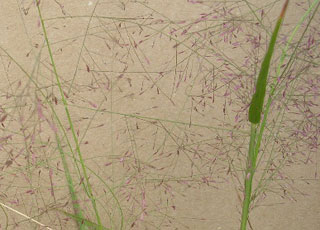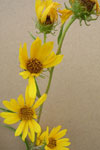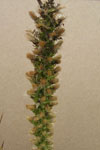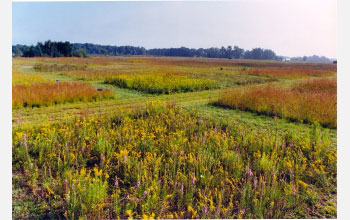Human Flower Project
Sunday, December 10, 2006
Wildflower Mix Goes Vroom
A Minnesota researcher finds native prairie plants and flowers outperform monocrops by a mile.

Lovegrass grown on a former rice farm, Pierce, Texas
Below: Maximilliam sunflower, gayfeather, and bushy
bluestem.
Photos: David Todd
Could the fuel crisis lead to laissez-faire farming?
David Tilman, a biologist at University of Minnesota, probably wouldn’t call it that. But in ten years of experimentation at Cedar Creek Natural History Area 30 miles north of Minneapolis/St. Paul, Tilman has found that when lots of native plants of the prairie are grown all together, they produce more efficient and eco-friendly fuel than single crop intensive agriculture can. To this point, mega-rowcrops like corn, sunflowers, and soybeans, have dominated the biofuels research effort (hmm, why might that be?). Tilman’s latest study, released today in Science magazine may turn that big rig around.
 He writes, “High-diversity grasslands had increasingly higher bioenergy yields that were 238% greater than monoculture yields after a decade.”
He writes, “High-diversity grasslands had increasingly higher bioenergy yields that were 238% greater than monoculture yields after a decade.”
Further, the mix of prairie plants can do well on poor soils (no need for expensive fertilizers). And the process for converting the grasses and wildflowers into fuel is “carbon-negative—meaning the plants can store more carbon in their roots than they will create during their conversion to biofuels or electricity.” This article will set you chemists aglow with more information.
 Tilman is at the forefront of this research on the benefits of native grasslands, though prairie advocacy has been mounting with enough force to waken Laura Ingles Wilder from the sod.
Tilman is at the forefront of this research on the benefits of native grasslands, though prairie advocacy has been mounting with enough force to waken Laura Ingles Wilder from the sod.
 Our friend and neighbor David Todd, who leads the ambitious Texas Legacy Project, wrote us a couple of months ago about visiting Pierce, TX. “Pierce was the heart of the old Shanghai Pierce ranching empire, down between Wharton and El Campo,” he said. “Like a lot of the old coastal ranches, they have been hit pretty hard by the collapse in rice prices and slow decline in oil and gas production, and are looking for alternatives.”
Our friend and neighbor David Todd, who leads the ambitious Texas Legacy Project, wrote us a couple of months ago about visiting Pierce, TX. “Pierce was the heart of the old Shanghai Pierce ranching empire, down between Wharton and El Campo,” he said. “Like a lot of the old coastal ranches, they have been hit pretty hard by the collapse in rice prices and slow decline in oil and gas production, and are looking for alternatives.”
David met with Bill Stransky, who’s been encouraging the ranch owners “to capitalize on the 300 or so acres of native coastal tallgrass prairie that they have scattered around the ranch, and sell the seed from those prairies for prairie reconstruction elsewhere.” Such reconstruction would, of course, be a crucial step in developing Tilman’s discoveries if we get serious about biofuels.
 Experimental plots at Cedar Creek Natural History Area: one planted “with four species of flowering prairie plants known as forbs. The adjacent plots, in clockwise rotation, are planted with eight species, four species and 16 species.”
Experimental plots at Cedar Creek Natural History Area: one planted “with four species of flowering prairie plants known as forbs. The adjacent plots, in clockwise rotation, are planted with eight species, four species and 16 species.”
Photo: David Tilman
Check out some of the photos from Cedar Creek, both aerial and ground level. Reconstructing “diversity” looks pretty arduous and peculiar, with plant combinations sliced into research grids. It’s going to be a long way back from fossil fuels and megafarming, but Tilman—David Todd and Bill Stransky, too—have us headed in the right direction.




